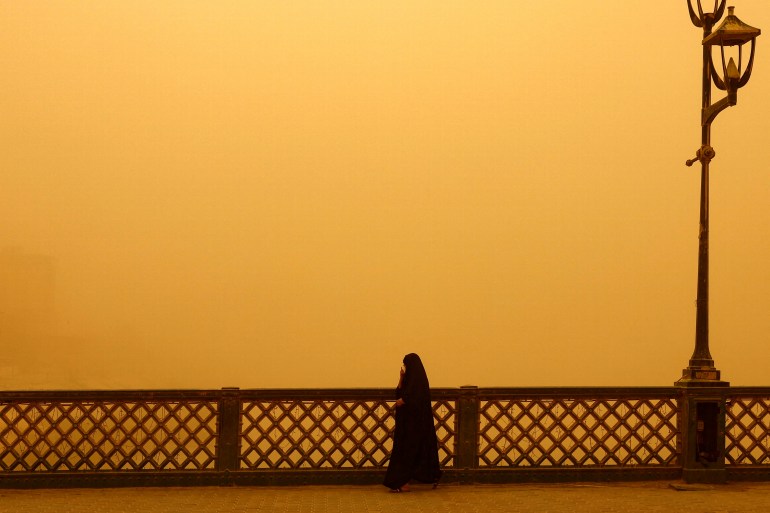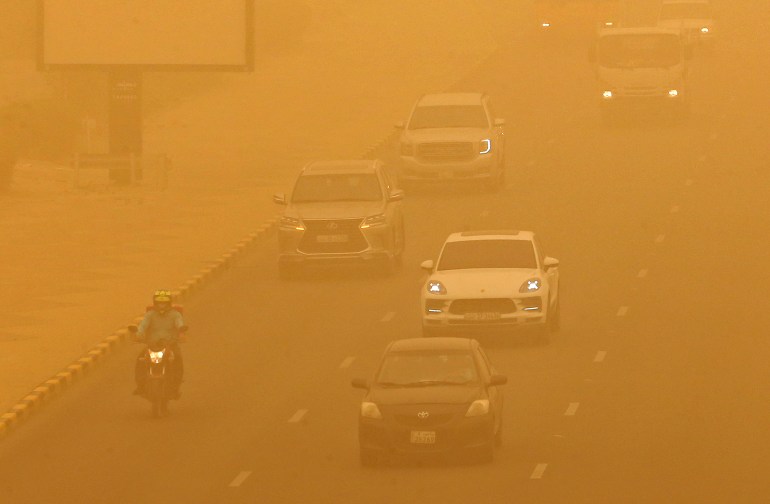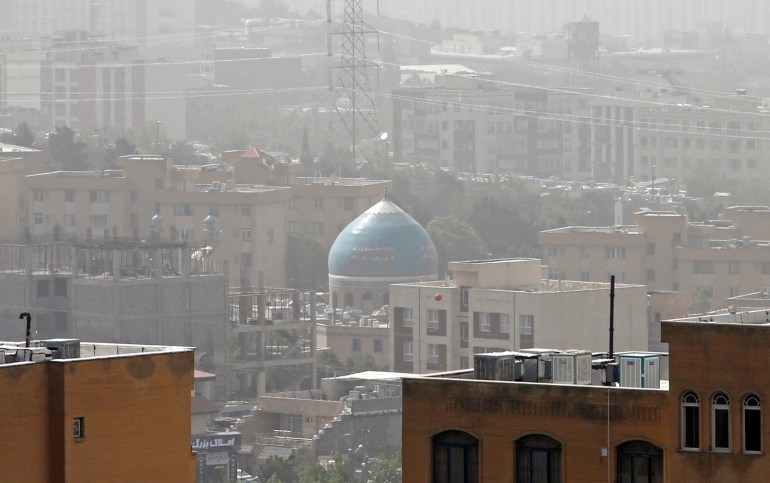Sandstorms pose serious risk to human health
by Naharnet Newsdesk

Sandstorms have engulfed the Middle East in recent days, in a phenomenon experts warn could proliferate because of climate change, putting human health at grave risk.
At least 4,000 people went to hospital Monday for respiratory issues in Iraq where eight sandstorms have blanketed the country since mid-April.
That was on top of the more than 5,000 treated in Iraqi hospitals for similar respiratory ailments earlier this month.
The phenomenon has also smothered Iran, Kuwait, Saudi Arabia and the United Arab Emirates with more feared in the coming days.
Strong winds lift large amounts of sand and dust into the atmosphere, that can then travel hundreds, even thousands, of kilometers (miles).
Sandstorms have affected a total of 150 countries and regions, adversely impacting on the environment, health and the economy, the World Meteorological Organization (WMO) said.
“It’s a phenomenon that is both local and global, with a stronger intensity in areas of origin,” said Carlos Perez Garcia-Pando, a sand and dust storm expert at the Barcelona Supercomputing Center and the Catalan Institution for Research and Advanced Studies.
The storms originate in dry or semi-dry regions of North Africa, the Arabian Peninsula, Central Asia and China.
Other less affected areas include Australia, the Americas and South Africa.
The UN agency WMO has warned of the “serious risks” posed by airborne dust.
The fine dust particles can cause health problems such as asthma and cardiovascular ailments, and also spread bacteria and viruses as well as pesticides and other toxins.
“Dust particle size is a key determinant of potential hazard to human health,” the WMO said.
Small particles that can be smaller than 10 micrometres can often become trapped in the nose, mouth and upper respiratory tract, and as a result it is associated with respiratory disorders such as asthma and pneumonia.
– ‘Unbreathable’ –
The most at-risk are the oldest and youngest as well as those struggling with respiratory and cardiac problems.
And the most affected are residents in countries regularly battered by sandstorms, unlike in Europe where dust coming from the Sahara is rare, like the incident in March.
Depending on the weather and climate conditions, sand dust can remain in the atmosphere for several days and travel great distances, at times picking up bacteria, pollen, fungi and viruses.
“However, the seriousness is less than with ultrafine particles, for example from road traffic, which can penetrate the brain or the blood system,” says Thomas Bourdrel, a radiologist, researcher at the University of Strasbourg and a member of Air Health Climate collective.
Even if the sand particles are less toxic than particles produced by combustion, their “extreme density during storms causes a fairly significant increase in cardio-respiratory mortality, especially among the most vulnerable,” he said.
With “a concentration of thousands of cubic micrometers in the air, it’s almost unbreathable”, said Garcia-Pando.
The sandstorms’ frequency and intensity could worsen because of climate change, say some scientists.
But the complex phenomenon is “full of uncertainties” and is affected by a cocktail of factors like heat, wind and agricultural practices, Garcia-Pando told AFP.
“In some areas, climate change could reduce the winds that cause storms, but extreme events could persist, even rise,” he said.
With global temperatures rising, it is very likely that more and more parts of the Earth will become drier.
“This year, a significant temperature anomaly was observed in East Africa, in the Middle East, in East Asia, and this drought affects plants, a factor that can increase sandstorms,” the Spanish researcher said.
Source Associated Press
https://www.naharnet.com/stories/en/289931-sandstorms-pose-serious-risk-to-human-health
Sandstorm blankets parts of Middle East, raising alarm – Al Jazeera
An unprecedented wave of sandstorms is striking parts of the region, with experts blaming climate change and poor government regulations.

Published On 23 May 2022
A sandstorm has blanketed parts of the Middle East, including Iraq, Syria and Iran, sending hundreds of people to hospitals and disrupting flights in some places.
From Riyadh to Tehran, bright orange skies and a thick veil of grit signalled yet another stormy day on Monday in what was the latest in a series of unprecedented nearly back-to-back sandstorms this year that have bewildered residents and raised alarm among experts and officials, who blame climate change and poor governmental regulations.
Keep reading
list of 3 itemslist 1 of 3
Climate emergency: The most extreme weather events of 2021
list 2 of 3
Climate change is devastating the Global South
list 3 of 3
Key climate change indicators hit record highs in 2021: UN report
end of list
Sandstorms are typical in late spring and summer, spurred by seasonal winds. But this year they have occurred nearly every week in Iraq since March.
Iraqi authorities declared the day a national holiday, urging government workers and residents to stay home in anticipation of the 10th storm to hit the country in the last two months. The Iraqi Ministry of Health stockpiled canisters of oxygen at facilities in hard-hit areas, according to a statement.
More than 1,000 people were hospitalised across the nation with respiratory problems, Ministry of Health Spokesman Seif al-Badr told AFP news agency.
“It’s a region-wide issue, but each country has a different degree of vulnerability and weakness,” said Jaafar Jotheri, a geoarchaeologist at the University of Al-Qadisiyah in Baghdad.

Specifically in Iraq, Jotheri explained, desertification exacerbated by record-low rainfall is adding to the intensity of storms. In a low-lying country with plenty of desert regions, the impact is almost double, he said. “Because of 17 years of mismanagement of water and urbanisation, Iraq lost more than two-thirds of its green cover,” he said. “That is why Iraqis are complaining more than their neighbours about the sandstorms in their areas.”
In Syria, medical departments were put on alert as the sandstorm hit the eastern province of Deir el-Zour that borders Iraq, Syrian state TV said. Earlier this month, a similar storm in the region left at least three people dead and hundreds were hospitalised with breathing problems.
Bashar Shouaybi, head of the Syrian Ministry of Health’s office in Deir el-Zour, told state TV that hospitals were prepared and ambulances were on standby. He said they have acquired an additional 850 oxygen tanks and medicine needed to deal with patients who have asthma.

The sky in Kuwait turned bright orange as a severe sandstorm blanketed the country. And for the second time this month, Kuwait International Airport suspended all flights because of the dust. Earlier this month, another storm forced all schools and government offices to shut down.
The second heavy sandstorm in less than a week descended on Saudi Arabia’s capital Riyadh as well, obscuring iconic buildings like the Kingdom Centre in a grey haze. Officials warned drivers to go slowly. Emergency rooms in the city were flooded this month with 1,285 patients complaining they couldn’t breathe properly.
Iran last week shut down schools and government offices in the capital of Tehran over a sandstorm that swept the country. It hit hardest in the nation’s southwest desert region of Khuzestan, where more than 800 people sought treatment for breathing difficulties.

Dozens of flights out of western Iran were cancelled or delayed. Blame over the dust storms and heavy air pollution has mounted, with a prominent environmental expert telling local media that climate change, drought and government mismanagement of water resources are responsible for the increase in sandstorms. Iran has drained its wetlands for farming – a common practice known to produce dust in the region.
Alireza Shariat, the head of an association of Iranian water engineers, told Iran’s semiofficial ILNA news agency last month that he expected extensive dust storms to become an “annual springtime phenomenon” in a way Iran has never seen before.
https://www.aljazeera.com/news/2022/5/23/sandstorm-blankets-parts-of-middle-east-raising-alarm
Schools, offices close in Tehran as sandstorm hits Iran – Naharnet
by Naharnet Newsdesk 17 May 2022

Schools and government offices closed in the Iranian capital on Tuesday and elsewhere in the country after yet another sandstorm blanketed Tehran, state TV reported.
The report said the air quality was very poor and that the pollution from the dust was high. It was the third severe sandstorm in Iran since mid-April.
Last week, authorities also shuttered schools in Tehran and other provinces because of a similar sandstorm but Tuesday marks the first time government offices closed in Tehran due to a sandstorm.
Tehran is among the most polluted cities in the world. The country’s west, along the border with Iraq, has seen frequent closures of schools and offices due to sandstorms. On Monday, airports in western Iran saw dozens of flights canceled or delayed.
In neighboring Iraq, sandstorms — at least eight since April — have landed thousands in hospitals with severe respiratory problems and killed at least one person. In Syria, at least three people died along the border with Iraq because of the storm.
Experts blame poor government policies, desertification and low water levels as well as climate change for the frequency and intensity of recent sandstorms.
Source Associated Press
https://www.naharnet.com/stories/en/289847-schools-offices-close-in-tehran-as-sandstorm-hits-iran
Sandstorm blankets Saudi capital in grey haze – Naharnet
by Naharnet Newsdesk 17 May 2022

A sandstorm engulfed Saudi Arabia’s capital and other regions of the desert kingdom Tuesday, hampering visibility and slowing road traffic.
A thick grey haze made iconic Riyadh buildings such as Kingdom Centre nearly impossible to see from more than a few hundred meters (yards) away, though there were no announced flight delays or cancellations.
The kingdom’s meteorology center forecast “surface dusty winds” in the country’s east and in Riyadh, “reducing horizontal sight”, according to the official Saudi Press Agency.
Dusty conditions were also expected farther west in the holy cities of Mecca and Medina, according to the forecast.
Electronic signs along Riyadh’s highways warned drivers to reduce their speed because of the lower visibility.
In central Riyadh, sand layered cars and buildings, and residents struggled to keep it out of their homes.
“Working outside is very difficult because of the dirt,” a Pakistani construction worker who gave his name as Kalimullah told AFP as he installed tiles.
“I try to wash my face from time to time,” the 30-year-old added, wrapping a piece of cloth around his face to block the sand.
Saudi office worker Abdullah Al-Otaibi said he was grateful he works indoors.
“Dust storms are part of our culture and we are used to it, but some of them are severe,” said Al-Otaibi, 39, rubbing his eyes as he hurried into his office building.
Parts of Saudi Arabia typically see sandstorms between March and May, with varying intensity. The frequency of the storms has increased in recent months in the region.
Neighboring Iraq has experienced eight sandstorms since mid-April, a phenomenon fuelled by soil degradation, intense droughts and low rainfall linked to climate change.
In Iran on Tuesday, government offices and schools and universities were closed in many provinces due to “unhealthy weather” and sandstorms, state media reported.
Source Associated Press
https://www.naharnet.com/stories/en/289849-sandstorm-blankets-saudi-capital-in-grey-haze
World’s tallest building engulfed as Mideast sandstorms hit UAE – Naharnet

The world’s tallest building disappeared behind a grey layer of dust on Wednesday as sandstorms that have swept the Middle East hit the United Arab Emirates, prompting weather and traffic warnings.
The 828-meter (2,716 ft, 6ins) Burj Khalifa, which towers over Dubai and is usually visible across the busy financial hub, retreated behind a curtain of airborne dirt that shrouded much of the country.
The UAE is just the latest country in the path of sandstorms that have smothered Iraq, Kuwait, Saudi Arabia, Iran and others in recent days, closing airports and schools and sending thousands to hospital with breathing problems.
Capital city Abu Dhabi’s air quality index (AQI) soared into the “hazardous” zone overnight, according to waqi.info and the Plume pollution app.
The Middle East’s sandstorms are becoming more frequent and intense, a trend associated with overgrazing and deforestation, overuse of river water and more dams.
Experts say the phenomenon could worsen as climate change warps regional weather patterns and drives desertification.
Emirati authorities issued a nationwide warning urging residents to remain vigilant.
“Abu Dhabi Police urges drivers to be cautious due to low visibility during high winds and dust,” the police force tweeted, as residents took to social media to publish photos and videos.
“Please do not be distracted by taking any videos or using your phone,” it added.
– ‘Hazardous weather’ –
A National Center for Meteorology graphic showed nearly all the country covered by the storm, with the warning: “Be on the alert: hazardous weather events are expected.”
Winds with speeds up to 40 kilometers (25 miles) per hour are blowing the dust, it said, reducing visibility in some areas to less than 2,000 meters (2,200 yards).
However, a Dubai airports spokesman said there was no impact on air traffic. Weather conditions were expected to remain the same for the next few days.
In neighboring Saudi Arabia, badly hit on Tuesday, conditions eased in the capital Riyadh on Wednesday but continued to restrict visibility in the city center.
Emergency rooms in Riyadh hospitals received some 1,285 people suffering from respiratory problems over 24 hours from the sandstorm, the state-run Al-Ekhbariya channel reported late on Tuesday.
The Saudi national weather center reported that dust was also affecting visibility in the west and south, specifically in Assir, Najran, Hael and Medina provinces. Medina is home to Medina city, the second-holiest city in Islam.
The center predicted another sandstorm would arrive in the kingdom by Sunday. Source
